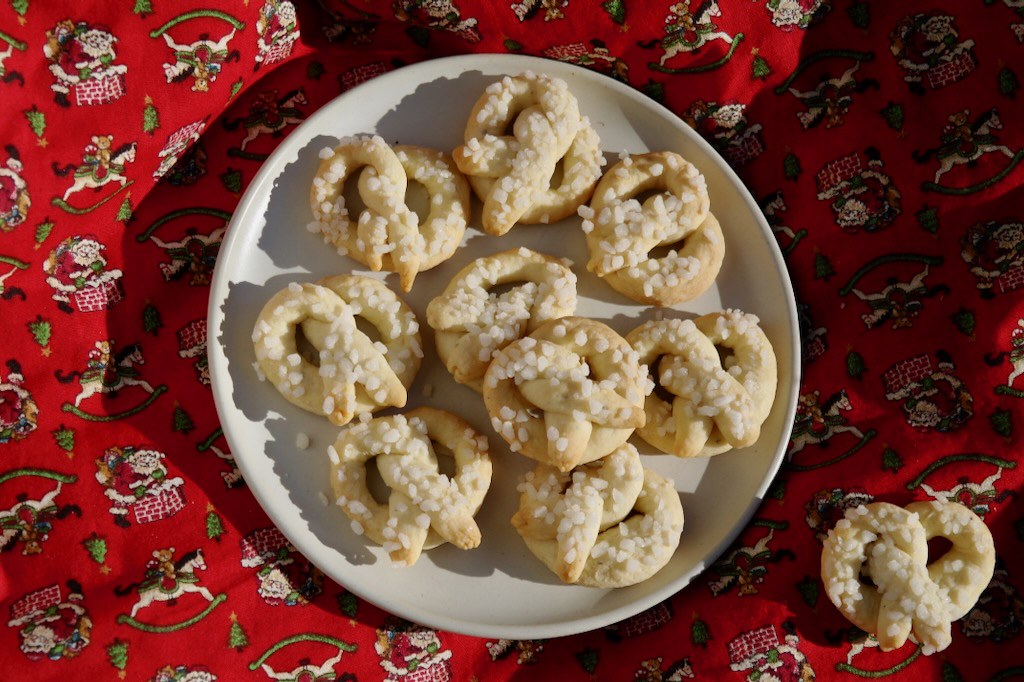
Usually I think of pairing earl grey with bright fruity flavours (citrus! raspberry! rhubarb!), but in this basque-style cheesecake, I went the complete opposite with chestnut. It’s a combo that came to me on a whim, but I really enjoyed it!
The first time I made this cake, I felt doubtful that the earl grey would come through. But it does, thanks to a lot of earl grey and a long infusion of the cream. With about half of the cream cheese subbed for chestnut puree, the chestnut does not get lost either. Using homemade chestnut puree does result in a less creamy consistency – the cheesecake will be soft, but firm, and not the soft silkiness of just cream cheese; but for me, I think it’s an adequate tradeoff for all the chestnut flavour!
For this cheesecake, I’ve lined the bottom and sides of a cake tin separately with parchment paper as it gives smoother and darker – but also sort of overbaked – edges compared to the usual parchment paper crumple, but either works. I do love the informality of the crumpled parchment, and it helps insulate the edges from overbaking!
I also use a different baking protocol than most recipes, which I’ve found necessary to get a nice darkened top and soft centre for a smaller and lower sugar basque cheesecake. I’ve found the cake should bake for about 30 minutes total (at least in my oven) for a soft centre, but with the last few minutes spent under the broiler. I also make sure to bake the cake on the middle rack, not lower third (standard for most baked goods) for more top browning. But of course as ovens vary, pay attention to how your cake is looking and adjust the process as needed.
Every time I’ve baked this cheesecake I’ve gotten cracks on top – I think it may be because pureeing the chestnuts introduces quite a bit of air that’s hard to get rid of (you may be able to avoid this by substituting about 250g commercial chestnut puree?). However, I don’t mind – this is already a pretty rustic cheesecake, and the cracks may be just more character?! Just be warned that they’ll likely appear!

earl grey chestnut basque cheesecake
A cheesecake with a surprising amount of chestnut and earl grey flavour. A note on the texture: because this cake is half chestnut puree, it’s soft, but firm, and not silky, with a more classic baked cheesecake texture.
equipment: one 7 to 7 1/2″ round cake tin at least 2″ tall
infused cream
- 300g heavy cream
- 12g loose leaf earl grey tea
chestnut puree
- 200g cooked peeled chestnuts (most convenient is to use the ones that come in foil packets)
cheesecake
- 300g block cream cheese
- 10g cornstarch
- 150g sugar
- 1/2 tsp kosher salt
- 3 large eggs
To infuse the cream, combine the cream and tea in a container and place it in the fridge overnight or for up to 48h for a cold infusion. Pass through a sieve and press to extract as much cream as possible from the leaves. Measure the resultant cream and top up with additional cream to 250g.
For the chestnut puree, place the chestnuts in a saucepan and cover with water. Bring to a simmer, cover and let simmer away for 15 minutes or until chestnuts are soft when pierced with a fork. Scoop out into the bowl of a food processor along with about 1/4 cup of the cooking water. Puree, scraping down the sides as needed, until a smooth paste is formed, adding more water if necessary.
For the cheesecake, preheat the oven to 480F with a rack set in the middle of the oven (while the usual standard for baking is lower third, in this case the middle rack will help the cheesecake brown much better). There are a couple ways to prepare the cake tin. The classic method is to line bottom and sides with a single square of parchment paper (embrace the crinkles!) just by pushing it into the tin. Or what I’ve done for this cheesecake for a rounder appearance (though the edges do get overbaked…): butter a 7 1/2″ to 7″ round cake tin (at least 2″ tall). Line the bottom with a round of parchment paper and the sides with a collar of parchment paper. Optionally, to help you pull out the cheesecake you can put two strips of parchment paper at right angles under the round of paper so that the ends stick out (a technique from here), but this is a pretty hardy cheesecake which is fine to invert out of the pan.
In a large bowl, cream the cream cheese until smooth to get rid of any lumps. Then add the chestnut puree, and mix until smooth. In a small bowl, stir together the cornstarch, sugar and salt. Add the cornstarch mixture to the cream cheese and combine. Beat the eggs in another small bowl until smooth, and add, a bit at a time, to the cream cheese mixture. Place the 250g infused cream in a microwave safe measuring cup or dish and heat until it begins to bubble. Stir into the batter (the hot cream helps any bubbles come out).
At this point you can pass the batter through a strainer to remove any chestnut bits (optional – it does make the cheesecake slightly smoother). Transfer the batter to the prepared tin and rap on the counter to pop large bubbles.
Bake the cheesecake for about 30 minutes total, or until it is set around the edges but wobbly in the middle when shaken. Check the cheesecake at the 26 minutes point to how the top is browning. If it is not getting quite dark, turn on the broiler. In my oven, this cake needs about 3-4 minutes under the broiler while on the middle rack to achieve a nice darkened surface. Watch the cake and rotate occasionally to get even browning. Once it is browned, take it out.
On the other hand, if the cake has blackened before the 30 minute point, turn off the broiler (return to fan or normal bake at 480F) and place some foil overtop of the cake. Once the full bake time has been reached and the cake is set on the edge, but nice and jiggly in the middle, remove from the oven.
I prefer to let the cake cool and then chill in the fridge completely before removing from the pan and slicing.










































































